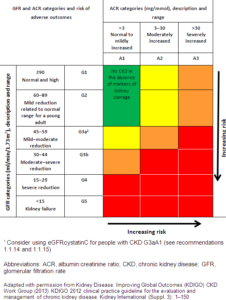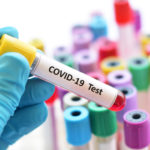
Renal Testing
Renal Testing
Chronic kidney disease (CKD) has continued to burden the global population as illustrated through its increasing contribution to mortality and morbidity rates and the associated financial costs. In Europe, it is estimated that CKD accounts for 1.3% of total healthcare costs. Between 9.1% and 13.4% (700 million and one billion) of the global population have CKD. These estimates combined with the increasing global health burden of CKD, highlights the need for a superior marker for CKD classification for early diagnosis and treatment interventions 1.
CKD Classification
The National Institute for Health and Care Excellence (NICE) recommends the creatinine-based estimate of glomerular filtration rate (eGFR) and albumin:creatinine ratio (ACR) aids in the risk stratification of CKD patients. Patients are classed in G1-G5 based on their eGFR, and A1-A3 based on their ACR as highlighted in table 1 below 2.
Table 1: Classification of CKD using GFR and ACR Categories 2

The main inadequacy of using creatinine for CKD classification is that it must be used with caution as creatinine is the by-product of muscle metabolism. Psychological changes in muscle mass will cause a variation in the creatinine pool independently of any GFR changes. As such, age, gender and ethnicity must be taken into consideration when utilising creatinine for renal function testing 3.
A Biomarker in Renal Function Testing
Cystatin C is an earlier and more accurate biomarker of GFR in the diagnosis of CKD and is particularly useful in patients where creatinine is an inadequate marker. Cystatin C is a low-molecular weight (13-kDa) cysteine proteinase inhibitor protein, produced at a constant rate by all nucleated cells. It is freely filtered by the glomerular membrane in the kidneys with near-complete reabsorption and catabolism in the proximal tubule with no significant urinary excretion. Cystatin C levels are significantly less affected by patient characteristics, including: age, body size and composition, gender, and nutritional status 4.
Several publications support the utility of cystatin C in renal testing.
- Cystatin C is indispensable for evaluation of kidney disease (2017) 5
A systemic minireview of 3,500 publications in PubMed using the search term “Cystatin C AND (renal OR kidney)” found that cystatin C should be an integral part of the evaluation of kidney status of patients. The study concluded that eGFR cystatin C was superior that eGFR creatinine as eGFR cystatin C does not require vague terms, such as race or sex and it is useful in children and adults, including the elderly. However, using both greatly improves GFR estimations.
- Creatinine versus cystatin C for renal function-based mortality prediction in an elderly cohort: The Northern Manhattan Study (2020) 6
The Northern Manhattan Study (NOMAS) is a multi-ethnic prospective cohort study, consisting of 3,298 elderly stroke-free participants recruited between 1993 and 2001, with a median follow-up of 18 years. The study concluded that low eGFR was associated with the risk of all-cause mortality in an elderly, race/ethnically diverse cohort. eGFR based on cystatin C was a superior predictor of all-cause mortality compared to creatinine.
Other Renal Function Tests
Some of the other common renal function tests offered include:
- Albumin & Microalbumin
Albumin is one of the first proteins to leak when the kidneys are damaged. Microalbumin is utilised it the early diagnosis of kidney damage and is recommended in those who are at a high risk of kidney disease, including diabetics and those with high blood pressure 7.
- Beta-2-Microglobulin (β2M)
β2M is inversely correlated with GFR and is associated with very early stage nephropathy in type 2 diabetes mellitus (T2DM) patients, and is associated with mortality in end-stage kidney disease (ESKD) patients 8.
- Urea
Urea is the nitrogenous end product of amino acid and protein catabolism. Healthy kidneys remove more than 90% of blood urea, and so elevated levels can suggest acute or chronic kidney disease 9.
Quote our promotional code ‘RENAL23’ when ordering from the Biorex Renal Panel throughout March 2023.
Biorex Renal Testing Panel
At Biorex, we offer a range of clinical chemistry reagents, analyser specific reagents, rapids tests, controls and calibrators to aid in renal function testing.
| Product Name | Product Type |
| Albumin | Clinical Chemistry Reagent |
| Albumin | System Reagent |
| Beta-2-Microglobulin | Clinical Chemistry Reagent |
| Beta-2-Microglobulin | System Reagent |
| Creatinine | Clinical Chemistry Reagent |
| Creatinine | System Reagent |
| Cystatin C | Clinical Chemistry Reagent |
| Cystatin C | System Reagent |
| Cystatin C | Calibrator & Controls |
| Microalbumin | Clinical Chemistry Reagent |
| Microalbumin | System Reagent |
| Microalbumin | Calibrator & Controls |
| Urea | Clinical Chemistry Reagent |
| Urea | System Reagent |
| Urinary Protein | System Reagent |
| Urinary & CSF Protein | Clinical Chemistry Reagent |
| Urine Strip (11 Parameter) | Urinalysis |
References
- Sundström J, Bodegard J, Bollmann A, Vervloet MG, Mark PB, et al. Prevalence, outcomes, and cost of chronic kidney disease in a contemporary population of 2·4 million patients from 11 countries: The CaReMe CKD study. The Lancet 2022; 20(100438). https://www.thelancet.com/action/showPdf?pii=S2666-7762%2822%2900132-6 (accessed 17 February 2023).
- Chronic kidney disease: assessment and management. https://www.nice.org.uk/guidance/ng203/chapter/Recommendations#classification-of-ckd-in-adults (accessed 17 February 2023).
- Bargnoux AS, Kuster N, Cavalier E, L Piéroni, Souweine JS, et al. Serum creatinine: advantages and pitfalls. Journal of Laboratory and Precision Medicine 2018; 3(71). https://jlpm.amegroups.com/article/view/4469/pdf (accessed 17 February 2023).
- Benoit S, Ciccia EA, Devarajan P. Cystatin C as a biomarker of chronic kidney disease: latest developments. Expert Review of Molecular Diagnostics 2020; 20(10). https://www.ncbi.nlm.nih.gov/pmc/articles/PMC7657956/pdf/nihms-1596901.pdf (accessed 24 February 2023).
- Grubb A. Cystatin C is Indispensable for Evaluation of Kidney Disease. The Journal of the International Federation of Clinical Chemistry and Laboratory Medicine 2017; 28(4). https://www.ncbi.nlm.nih.gov/pmc/articles/PMC5746836/ (accessed 24 February 2023).
- Wiley JZ, Moon YP, Husain SA, Elkind MSV, Sacco RL et al. Creatinine versus cystatin C for renal function-based mortality prediction in an elderly cohort: The Northern Manhattan Study. PLoS One 2020; 15(1). https://www.ncbi.nlm.nih.gov/pmc/articles/PMC6961921/ (accessed 24 February 2023).
- Mayo Clinic. Microalbumin test. https://www.mayoclinic.org/tests-procedures/microalbumin/about/pac-20384640 (accessed 17 February 2023).
- Assounga AG. Beta 2 microglobulin in kidney failure: A review and an algorithm for renal replacement therapy. Saudi Journal of Kidney Diseases and Transplantation 2021; 32(5). https://pubmed.ncbi.nlm.nih.gov/35532690/ (accessed 17 February 2023).
- Lab Tests Online. Urea Test. https://labtestsonline.org.uk/tests/urea-test (accessed 20 February 2023).







